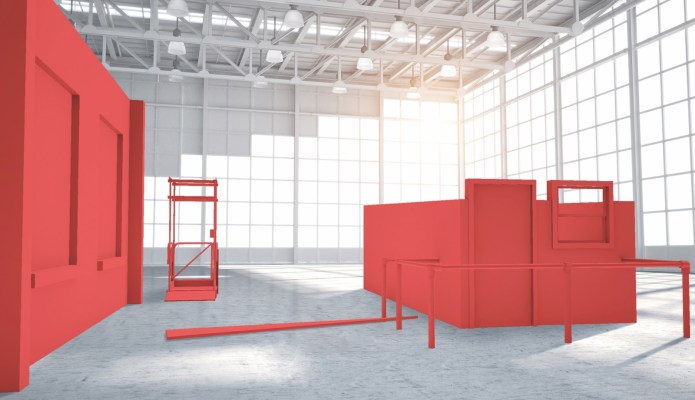On the outskirts of the Bay Area, my Lyft driver jokingly asked me if I wanted to leave him my number in case I didn’t return from where I was headed. I would soon be descending a set of stairs into the basement of a newly built, largely empty office complex where I was going to try an “experimental virtual reality experience.” I’ve seen enough Black Mirror to be skeptical of what could be coming next.
After being introduced to the team at Nomadic VR, a small virtual reality startup founded by ex-Lucasfilm special effects wizards, I was outfitted with a headset and backpack gaming computer and left walking down the creepishly quiet hallway of a virtual noir-styled office building. What was magic about this office was that it was a VR space designed to be touched. As I was urged to take a seat at a desk, I sat down on a physical stool that was being tracked virtually and looked at a computer monitor I could actually touch with my hands.
In an industry filled with a surplus of acronyms and terminology, Nomadic VR falls through the cracks of catch-alls like “virtual reality” or “mixed reality.” Nomadic is a bit of an outlier, with consumers strapped into virtual reality gear while being placed and tracked by infrared cameras in physical spaces specifically designed for the experiences. Reach out for a door handle in the game and you grab a real one, walk toward a railing and you bump into it, walk into a new room and feel the temperature change as the Nomadic-designed experiences play with your mind and emotions.
It’s difficult to convey what a cool feeling it is to reach for a virtual object and get the perfect tactile feedback you expect. I ran through the Nomadic experience a couple of times and whenever I was prompted to lean over to open the filing cabinet and wrap my fingers around a virtual/real pistol, a big smile came across my face. I don’t believe this is because I’m a closeted crazed killer, though parents and conservative family action groups are certainly going to have a heyday discussing the impact of violent VR games. What is ultimately most rewarding about Nomadic’s VR system is the scale you are able to feel.
Existing virtual reality setups may give you access to full control of visual and auditory controls, but touch feedback still has a long way to go. While it may eventually come to VR gloves and bodysuits, for now, experiences where real-world objects are tracked in real spaces may offer the most real-life immersion.
Virtual reality is a technology very much rooted in 1980s pop culture. While the headsets available then were either incredibly expensive or technically limited, movies like Tron and The Lawnmower Man approached the topic in a manner that exposed the public to the idea of VR as a gateway to extra-worldly experiences. Consumer-facing manifestations of VR landed in arcades in shopping malls and while the applications were largely goofy and gimmicky, the high visibility of the technology was there. Fast-forward a few decades and the American arcade has died, largely the result of increasingly inexpensive gaming systems that have brought high-end experiences into people’s living rooms. This next wave of VR brings a new chance for the reincarnation of the arcade — there’s finally a technology that’s expensive and requires a lot of space but seems to be an entertainment experience worth leaving the house for.
Nomadic hopes to bring their flavor of highly interactive narrative-based VR into cinemas across the country, allowing the spaces a modular VR entertainment setup that will easily fit into a gutted theater and is capable of being easily updated for new experiences without much fuss.
This model has a lot of potential for quick and seamless tie-ins to popular content already being released. Imagine checking out the latest Bond film, then being able to relive a fight sequence as Bond himself, transversing the physical space and bringing you closer to the experience and evolving your perceived experience with the film you just witnessed. While cinemas have shown resilience in the face of evolving video-on-demand services, it’s clear that both theater operators and movie studios are going to need to look more closely at drawing consumers into deeper experiences. Hollywood has shown particular excitement for VR, and while many Silicon Valley investors have been more hesitant to invest in consumer VR startups, there aren’t many studios ignoring VR.
Unlike existing competitors like The Void, Nomadic is looking to create experiences that can easily be integrated into existing spaces rather than in dedicated larger spaces.
Talk about VR arcades with anyone in the space and the topic of China will come up by the second sentence. Gaming cafes are very much a real thing in Asia, where people sit down at computers for hours at a time and game in public spaces. HTC has opened a dedicated VR gaming theme park (??) and has been doing some extensive work on enabling arcade operators to easily gain access to commercial licenses on VR titles through the company’s Viveport VR app store.
Nomadic VR is focusing the majority of its attention on the U.S. market for the time being, saying that while China has shown a hunger for VR content, the stuff that is being shown off in VR arcades is often lacking in quality.
Nomadic wants to create experiences that can live in theaters for a few months and then be updated with ease through its LEGO-like modular systems, where tracked objects can be inserted into spaces and interacted with by way of its proprietary VR hardware. Arcades may be a relic of the past, but as virtual reality grows more interactive, Nomadic wants to capture cinema-goers’ attention and excitement in a way that they will be able to feel.
